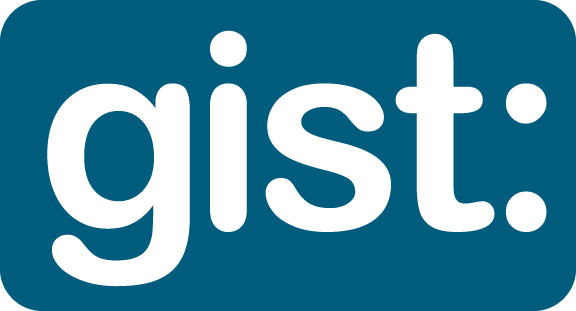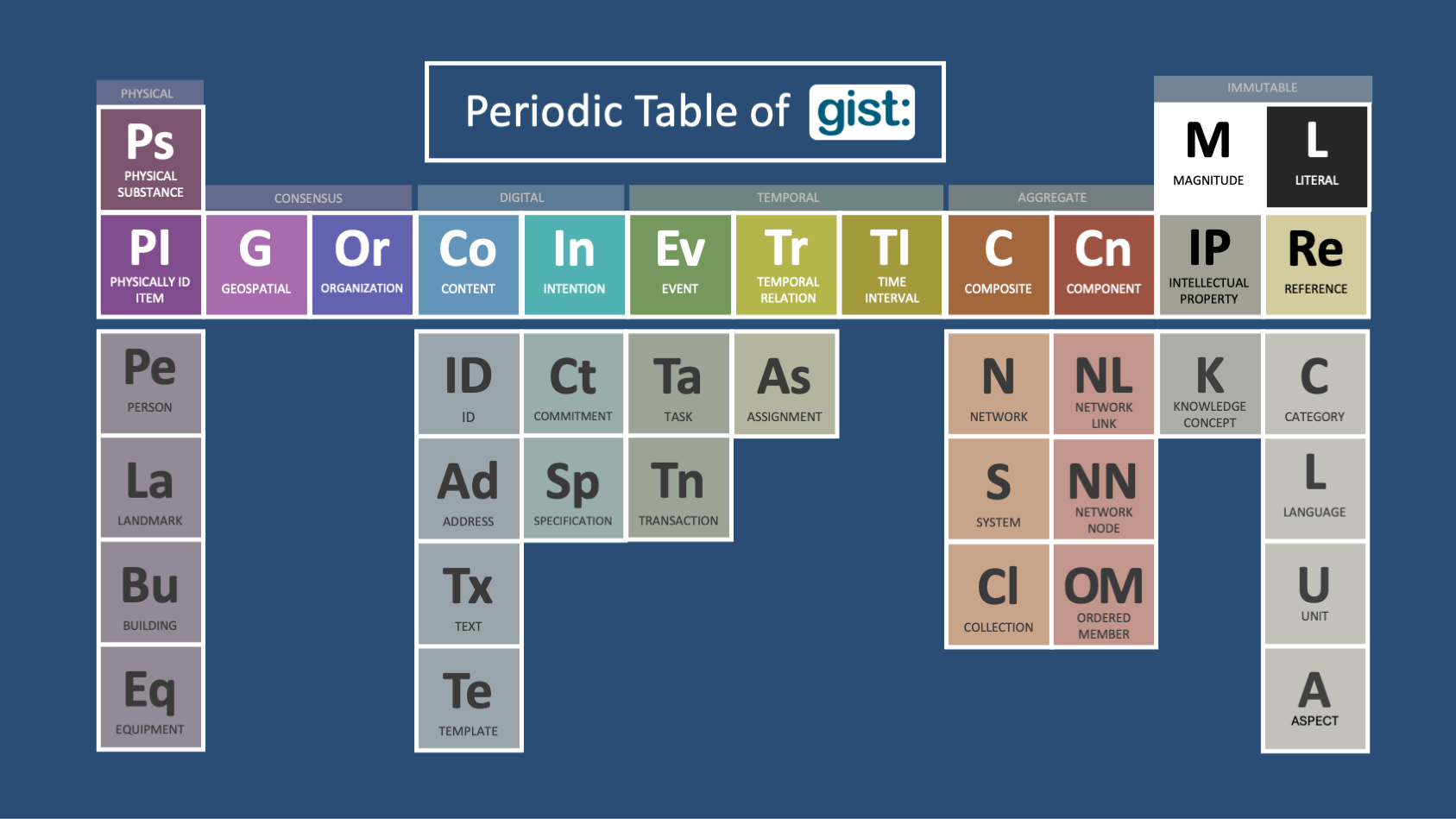
an upper ontology for the enterprise
gist is Semantic Arts’ minimalist upper ontology for the enterprise. It is designed to provide the maximum coverage of typical business concepts with the fewest number of primitives and the least amount of ambiguity.
gist represents the fundamental concepts and relationships that exist for most business use cases and is designed to be domain-independent. This flexibility allows gist to be applied to a wide spectrum of domains and facilitates both interoperability and integration of knowledge. We have designed gist for clarity and completeness to cover nearly all the concepts that exist in real-world ontology development.
Our gist ontology is free (as in free speech and free beer): it is distributed under the Creative Commons Attribution 4.0 International license. You can use it as you see fit for any purpose, as long as you give us attribution.
The gist ontology defines around 100 classes and about the same number of attributes and relationships and serves as a foundation for building more specialized ontologies. The gist periodic table is a graphical representation of gist coverage organized into abstract conceptual clusters.
Design Features
Significant design features of gist include:
gist defines a small number of top-level concepts on which everything else is based, both in gist itself and in enterprise or application ontologies that use gist as a foundation. These concepts are not philosophical abstractions with unfamiliar terms such as endurant, perdurant, or qualia; they are everyday concepts with ordinary names such as person, organization, and agreement, whose meanings are just what you would expect. These high-level concepts provide building blocks for defining more specific domain concepts in a gist-based ontology.
gist has extensive and fine-grained disjointness at the highest level in order to help you avoid making certain types of logical errors in your ontologies or data that are based on gist. By explicitly stating, for example, that governmental organizations (such as the US federal government) can’t be intergovernmental organizations (such as the UN), a reasoner will complain of logical inconsistency if something has been typed as both. Without disjointness, such inconsistencies will not be surfaced.
gist uses domain and range specifications sparingly in order to make properties more broadly applicable. To eliminate redundancy and reduce cognitive load, inverse properties are not defined. Subclasses are typically defined using a pattern that specifies how they specialize the superclass.
Latest Release
gist 14.0.0 was released on October 31, 2025. It is a major release that includes changes that break compatibility with previous versions of gist. The release package includes documentation and scripts to help you migrate your extension ontologies and instance data from earlier versions of gist.
The most notable changes in this release are:
- Introduction of a KnowledgeConcept class for expressing knowledge that arises from the distillation of experience. Using subclasses and instances of KnowledgeConcept, you can add more knowledge to your knowledge graph!
- Addition of an Assignment class and associated predicates to represent task assignments, pay rate assignments, supervisor assignments, etc.
- Full refresh of annotations, including definitions, scope notes, and examples, for greater clarity and consistency.
- More nuanced model of offers and associated predicates.
- More streamlined class hierarchy, including commitments and agreements, composites and components, geographic classes, and others.
See the release notes for full details of what’s new in gist 14.0.0.
The release package includes:
- The gist core ontology, serialized as Turtle, RDF/XML, and JSON-LD.
- Supplementary ontologies of RDFS annotations and materialized subclass inferences to support a variety of applications and reasoners.
- Documentation and release notes in both HTML and Markdown formats.
- Migration scripts and documentation to upgrade your ontologies and instance data to gist 14.
How to Get gist
Our gist ontology is free and distributed under the Creative Commons Attribution 4.0 International license, which only requires that you attribute the source (http://semanticarts.com/gist) when you use it. In addition, we require that any gist concepts remain in the gist namespace (https://w3id.org/semanticarts/ns/ontology/gist/) and that you not define your own terms within the gist namespace.
gist is publicly available from any of the following sources:
- Download the latest gist release package.
- Import gist directly into Protégé using the link https://w3id.org/semanticarts/ontology/gistCore
- Clone or download gist from the GitHub repository.
(Can’t afford free? Purchase a perpetual license)
Looking for an older version of gist? All former versions <link “former versions” to the Previous Versions page or heading> of gist are still available.
Getting Involved
Ongoing development of gist is open to the public at the gist GitHub repository. You can contribute to gist by adding your comments to issue discussion threads and submitting new issues and pull requests. Minutes from our biweekly internal development team meetings are posted on the repository wiki so you can find out what we’ve been discussing and get a preview of upcoming changes to gist.
gist Forum
We maintain an active gist community forum where practitioners and users of gist come together to discuss the gist model, implementation best practices, and evolution.
Virtual meetings are held on the third Tuesday of every other month at 11:30am mountain time, starting in January.
Recordings of past gist Forum are available on our YouTube playlist.
Interested in participating? Send an email to [email protected] and we will get you added!
Additional Resources
- The gist-doc GitHub repository provides an eBook, visualizations, and Widoco-style documentation of gist.
- Following is a chronological list of articles and videos about gist.
2024
- Units of Measure and Magnitude (Video)
- The New gist Model for Quantitative Data (Article)
2023
- Toward a Knowledge Ontology, Part 1 (Video)
- Toward a Knowledge Ontology, Part 2 (Video)
- Temporal Relations (Video)
- Removal of Inverses (Video)
- Knowledge Graph Modeling Using gist (Article)
- gist Jumpstart (Article)
- Extending an Upper-Level Ontology (like gist) (Article)
2022
- Ontology Documentation (Video)
- gist: An Introduction (Video)
- An Introduction to gist, Part 1 (Video)
- An Introduction to gist, Part 2 (Video)
- An Introduction to gist, Part 3 (Video)
- gist/BFO Comparison (Video)
- Get the gist, Start Building Simplicity Now (Article)
2021
- VIDEO: gist Council: versioning and depreciation: [LINK]
- VIDEO: gist Council: modeling with gist categories: [LINK]
- VIDEO: gist Council: does anybody use that, part 1: [LINK]
- VIDEO: gist Council: does anybody use that, part 2: [LINK]
- VIDEO: gist Council: categories and classes: [LINK]
- VIDEO: gist Council: using the gist ID: Class: [LINK]
- VIDEO: gist Council: documentation: [LINK]
- ARTICLE: telecom frameworx model [LINK]
2020
- VIDEO: De-modularize gist: [LINK]
- VIDEO: Working with dates in gist, OWL and RDF: [LINK]
- VIDEO: Part of: musings on mereology: [LINK]
- VIDEO: SemOps: DevOps for semantic systems: [LINK]
- VIDEO: General overview: [LINK]
- VIDEO: Events: [LINK]
- VIDEO: Entity/ Identity resolution: [LINK]
- VIDEO: gist Council – change management [LINK]
- VIDEO: Everyday modeling challenges, part [LINK]
- ARTICLE: A brief introduction to the gist Semantic Model [LINK]
Earlier
gist Extensions
Semantic Arts has developed a number of extensions of gist serving specific industries, including pharmaceuticals, accounting, computing, human resources, and professional services. While most of these are available only to our clients, two are publicly available on GitHub:
- gistBFO is a bridge ontology that supplements gist to provide alignment with the Basic Formal Ontology (BFO). Using gistBFO, you can get all the benefits of building your ontology with gist while maintaining compliance with BFO.
- gistCyber is a gist extension for the cybersecurity domain that includes subdomains for threat intelligence, vulnerabilities, attack patterns, and more.
Previous Versions of gist
All previous versions of gist are available using the links below.


